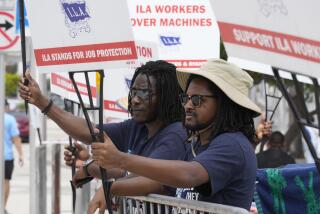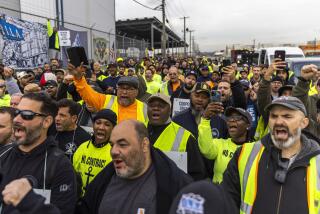Union, Nassco Plan Talks on Improving Carpenters’ Morale
- Share via
National Steel & Shipbuilding Co. officials have expressed concern about the low morale of some workers who were forced to take a sharp pay cut, a union leader said Thursday, and a meeting is scheduled today to discuss the problem.
Chuey Hernandez, business agent for the Carpenters Union Local 1300, said that he and other representatives from the local will meet with Nassco officials to seek ways to improve the morale of the about 200 shipyard workers represented by the union.
Carpenters were among the hardest hit in October, when Nassco officials unilaterally reduced union wages from 17% to more than 50% when the previous contract expired. The cutbacks spawned a bitter dispute that led to a three-week strike in August, before the carpenters and five other shipyard unions ratified a new agreement last week.
Still Earning Less
The new contract includes profit-sharing, but union workers will still be earning less than they did under the previous contract, which expired Sept. 30. Nassco officials said the lower wages are necessary to keep the shipyard competitive and profitable.
Hernandez, who said he has 20 years of seniority at Nassco, saw his hourly pay cut from $13.24 to $6.50 in October. Most carpenters are being paid $9.40 an hour under the new contract.
“During the negotiations, I told the company’s negotiators that our guys were not going to put much out for what they’re getting paid. . . . I got a call earlier today from Carl Hinrichsen,” he said of Nassco’s industrial relations manager. “He wants to meet to explore any options or opportunities to bring the workers’ morale back,” Hernandez said.
‘Morale Is Shot’
“To be honest, the workers’ morale is shot. . . . It’s going around the yard that they’re not going to do much work for the amount of money they’re getting paid,” he added.
During the strike, many Nassco workers found higher-paying jobs at other shipyards on the San Diego waterfront, and union officials have said that most of them will not return to Nassco. Hernandez estimated that about 25 carpenters have left Nassco for good and said that shop stewards estimate that as many as 12 more may quit.
“Most of the people who found jobs at other local shipyards are earning $10.80 an hour. Some guys went to shipyards in Portland, Ore., and San Francisco and are making as much as $14 an hour. These people aren’t coming back,” Hernandez said.
He said most of the carpenters who have gone to other jobs had as much as 15 years’ seniority at Nassco.
Difficult to Calculate
Nassco vice president and spokesman Fred Hallett said it is difficult to calculate how many workers have actually decided not to return to jobs at Nassco. Most strikers had until Thursday to report to work and, based on absentee records alone, Hallett estimated that perhaps 10 workers have decided to stay at other jobs.
On Thursday, officials from the Ironworkers Union Local 627 said some of their members have received letters from the company warning them of the danger of layoffs.
“The company has sent out a letter telling some workers that, if they have a job, to stay there because there’s going to be some layoffs at the yard,” said Manuel Ruiz, secretary-treasurer of Local 627.
Robert Godinez, president of Local 627, said the layoffs will occur in Nassco’s ship-repair division. The only repair contract that the company now has is a $60-million one with the Navy that is scheduled to end in November.
New Contract
Godinez said that, eventually, most laid-off workers will be recalled to work on a new $290-million construction contract for the AOE, a speedy Navy combat support ship. The contract, which is the only other contract that Nassco has landed, is scheduled to end in 1991.
Meanwhile, Godinez said, most unions are determined to work with Nassco officials to make the company profitable. Morrison-Knudsen, which is Nassco’s parent company, reported $20 million in losses for the shipyard for the second quarter of 1988.
“The unions are trying to do the best they can to work with the company now that there’s a profit-sharing plan in effect. If the company makes a profit, the worker will see some of that in his paycheck. It’s in our best interest to see that the company stays in business and makes a profit. We’re more or less a minority owner,” Godinez said.
More to Read
Inside the business of entertainment
The Wide Shot brings you news, analysis and insights on everything from streaming wars to production — and what it all means for the future.
You may occasionally receive promotional content from the Los Angeles Times.










